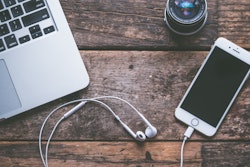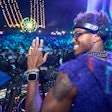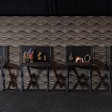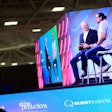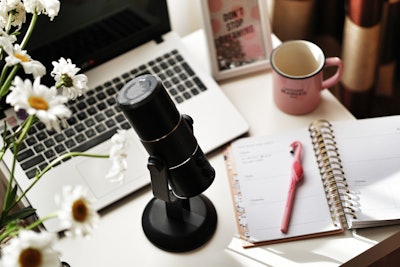
When self-described "drop-in audio app" Clubhouse debuted in 2020, event professionals were quick to explore the buzzy platform as an exciting new space for events and community-building. Last year, BizBash even chatted with one event producer who was hosting a full-day conference on the app, complete with a curated lineup of speakers and a hand-raising option for attendees to come "on stage" and share their input.
But after the initial hype, have these types of audio-only gatherings really gained much traction in the event industry?
A look at the recent rise in Clubhouse-inspired platforms certainly suggests there's a demand for the format. Last month, for example, LinkedIn launched its new Audio Events feature. Currently available in a beta phase, the virtual event offering allows members to listen in on conversations, see who else is at the virtual event, communicate with each other and even raise their hands to join the live conversation. (Later this spring, LinkedIn plans to expand its virtual event capabilities to include video, too.)
LinkedIn is just the latest in a long line of companies jumping on the audio-only bandwagon. Twitter began testing its new voice-based chat rooms called Spaces in late 2020, while Facebook rolled out its Live Audio Rooms in 2021. Last year also saw the debut of Spotify’s new social audio app Greenroom, which allows users to host and record live conversations that can later be distributed as podcasts, as well as Discord’s Stage Channels. Slack’s Huddles and Reddit’s Reddit Talk are also seemingly inspired by the Clubhouse model.
For many event planners, it may be tempting to write off these audio-only gathering spaces as a temporary fad—after all, isn't a successful event one that engages the five senses? But with the pandemic and the rise of virtual events leading to new ways to engage attendees, the trend may be worth a closer look.
But how do you truly engage attendees in an audio-only event? We reached out to some experts to get their top tips.
1. Be structured but still spontaneous.
For an audio-based event, Kacie Willis—an Atlanta-based sound designer, audio producer and podcaster, and the founder of production company Could Be Pretty Cool—advises finding a balance between the more casual conversations you'd find on a podcast and the more structured panels of a traditional conference.
“Keep your session well-organized, but don’t make it sound well-rehearsed,” she suggests. "When you have a podcast where it's just meandering thoughts, especially if it's an episode with multiple guests, it's almost unbearable to listen to. You want structure and some editing to make this conversation sound tight. But for a livestreamed audio event, the more well-rehearsed, the more scripted your session sounds, that's when people lose interest.”
2. Recognize that you may not have your attendees' full attention—and that's OK.
Willis—who was also part of Clubhouse’s inaugural "Creator First" program, which helped support emerging creators with resources like a monthly stipend, audio equipment and creative development help—thinks the time is right for a rise in audio-only events. After all, many potential attendees are still working from home or working in slightly empty offices where they feel freer to listen to music and podcasts.
“The advantage of audio-only events is actually that you don't have to engage all of your senses," she says. "You can be something that someone is still relatively actively listening to while they're doing other things, like working or driving. And in a way, it's almost as engaging because it allows you to multitask while still learning, while still being a fly on the wall while experts are having a conversation that feels really exclusive.”
Mason Quesnel of Centsr Media—which specializes in booking events and helping event staffers like musicians, artists and photographers navigate the industry—says his team has also focused heavily on audio-only events during the pandemic. “The medium has been great thus far because of its ease of use and accessibility; furthermore, audio-only allows guests to feel comfortable with being off-camera and engaged at their own discretion," he says.
3. Offer chat boxes or other ways for attendees to interact with each other—but designate a specific person to manage them.
One thing that can set audio events apart from, say, podcasts, is a level of interaction. Platforms like LinkedIn's allow attendees to interact with each other and connect during and after the event, for example. Having some sort of chat feature where attendees can ask questions to the speakers is also a great way to increase engagement.
But, Willis points out, monitoring a busy chat room can be distracting for speakers. Her recommendation? Have a designated person who can serve as a sort-of stage manager that is watching that chat. "That person is the one who can monitor what people are typing as the session's going on," she says. "They can be noting any questions that can be saved for later, and if there is a pertinent question that should be interjected in some way, they can ping the moderator and say, 'This person asked a really great question.' That way, the speakers can stay focused on whatever content they're delivering."
4. Consider an "on-stage" option too.
Many audio platforms can go beyond the chatbox, too, and actually allow attendees to be pulled "on stage"—aka, to have their mics unmuted so they can participate in the conversations. Willis notes that the audio-only component can actually be more inclusive in this sense, and make attendees a bit braver with participating when they don't have their cameras on. "It's like you're talking into your phone," she points out. "The stakes are lower when it comes to people feeling comfortable interacting with even very high-level professionals and high-level talent—which then allows those professionals to perhaps engage with listeners, potential customers and audience members in a way that they might not feel comfortable to do walking up to them after a session at a live, in-person event.”
5. Choose your speakers carefully.
Quesnel says that the biggest challenge of an audio-only event is getting attendees to stay engaged for the duration. “Due to its ease of use, the events become disposable to many, and it's difficult to have users commit to the entire event,” he explains. To help combat this, Quesnel and his team have been extra careful to curate speakers that appeal to their target demographic. “This has increased our retention. As a bonus, it's much easier to get credible names to commit to guest appearances, because it's easier for them to access and doesn't require all the headaches of traditional guest speaking.”
6. Make a plan to repurpose the content.
When Clubhouse initially launched, users didn't have the option to record conversations—but that changed a few months ago when it launched Replay, which allows audio chats to be recorded and saved to a club or profile. Other platforms have similar options; Willis, for example, hosted a livestream audio session on Spotify Greenroom that turned into a podcast episode for her show, You Heard Me Write.
“With so many of the livestream audio services now integrating features where you can record your sessions, I can see them being something that sticks around," predicts Willis. "You can record it and put that on a podcast feed, you can record it and put that on a website."
7. Remember that now is the time for innovation.
Above all else, now is the time to experiment. Attendees are open to new formats right now, and event professionals are discovering new methods of engagement. Willis' advice? Just try it. "You just have to jump in and try it," she says. "After you do one [audio event]—whether it's a workshop-style event, whether it's a panel-style event—you really learn a lot about what your audience wants. Just do one."




